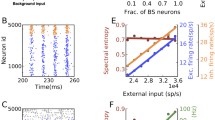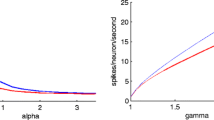Abstract
Stable signal transmission is crucial for information processing by the brain. Synfire-chains, defined as feed-forward networks of spiking neurons, are a well-studied class of circuit structure that can propagate a packet of single spikes while maintaining a fixed packet profile. Here, we studied the stable propagation of spike bursts, rather than single spike activities, in a feed-forward network of a general class of excitable bursting neurons. In contrast to single spikes, bursts can propagate stably without converging to any fixed profiles. Spike timings of bursts continue to change cyclically or irregularly during propagation depending on intrinsic properties of the neurons and the coupling strength of the network. To find the conditions under which bursts lose fixed profiles, we propose an analysis based on timing shifts of burst spikes similar to the phase response analysis of limit-cycle oscillators.
Similar content being viewed by others
References
Abeles M (1991). Corticonics: neuronal circuits of the cerebral cortex. Cambridge University Press, Cambridge
Beggs JM and Plenz D (2004). Neuronal avalanches are diverse and precise activity patterns that are stable for many hours in cortical slice cultures. J Neurosci 24: 5216–5229
Belykh I, de Lange E and Hasler M (2005). Synchronization of bursting neurons: what matters in the network topology. Phys Rev Lett 94: 188101
Butera RJ, Rinzel J and Smith JC (1999). Model of respiratory rhythm generation in the pre-botzinger complex. I. Bursting pacemaker neurons. J Neurophysiol 82: 382–397
Cateau H and Fukai T (2001). Fokker–Planck approach to the pulse packet propagation in synfire chain. Neural Netw 14: 675–685
Chaté H and Manneville P (1987). Transition to turbulence via spatio-temporal intermittency. Phys Rev Lett 58: 112–115
Chay TR and Keizer J (1983). Minimal model for membrane oscillations in the pancreatic β-cell. Biophys J 42: 181–190
Destexhe A and Contreras D (2006). Neuronal computations with stochastic network states. Science 314: 85–90
Diesmann M, Gewaltig M and Aertsen A (1999). Stable propagation of synchronous spiking in cortical neural networks. Nature 402: 529–533
Elezgaray J and Arneodo A (1992). Crisis-induced intermittent bursting in reaction-diffusion chemical systems. Phys Rev Lett 68: 714–717
Fellous JM, Tiesinga PH, Thomas PJ and Sejnowski TJ (2004). Discovering spike patterns in neuronal responses. J Neurosci 24: 2989–3001
Gammaitoni L, Hänggi P, Jung P and Marchesoni F (1998). Stochastic resonance. Rev Mod Phys 70: 223–287
Galan RF, Ermentrout GB and Urban NN (2005). Efficient estimation of phase-resetting curves in real neurons and its significance for neural-network modeling. Phys Rev Lett 94: 158101
Guckenheimer J and Holmes P (1983). Nonlinear oscillations, dynamical systems and bifurcations of vector fields. Springer, New York
Hahnloser RH, Kozhevvnikov AA and Fee MS (2002). An ultra-sparse code underlies the generation of neural sequences in a songbird. Nature 419: 65–70
Han SK, Kurrer C and Kuramoto Y (1995). Dephasing and bursting in coupled neural oscillators. Phys Rev Lett 75: 3190–3193
Hansel D, Mato G and Meunier C (1995). Synchrony in excitatory neural networks. Neural Comput 7: 307–337
Hindmarsh JL and Rose RM (1984). A model of neuronal bursting using three coupled first order differential equations. Proc R Sci Lond B 221: 87–102
Ivanchenko MV, Osipov GV, Shalfeev VD and Kurths J (2004). Phase synchronization in ensembles of bursting oscillators. Phys Rev Lett 93: 134101
Izhikevich EM (2000). Neural excitability, spiking and bursting. Int J Bifurcation Chaos 10: 1171–1266
Izhikevich EM (2006). Dynamical systems in neuroscience: the geometry of excitability and bursting. MIT, Cambridge
Jin DZ, Ramazanoglu FM and Seung HS (2007). Intrinsic bursting enhances the robustness of a neural network model of sequence generation by avian brain area HVC. J Comput Neurosci 23(3): 283–299
Kuramoto Y (1984). Chemical oscillations, waves and turbulence. Springer, Berlin
MacLean JN, Watson BO, Aaron GB and Yuste R (2005). Internal dynamics determine the cortical response to thalamic stimulation. Neuron 48: 811–823
Medvedev GS (2006). Transition to bursting via deterministic chaos. Phys Rev Lett 97: 048102
Mehring C, Hehl U, Kubo M and Diesmann M (2003). Aertsen A Activity dynamics and propagation of synchronous spiking in locally connected random networks. Biol Cybern 88: 395–408
Meucci R, Di Garbo A, Allaria E and Arecchi FT (2002). Autonomous bursting in a homoclinic system. Phys Rev Lett 88: 144101
Netoff TI, Banks MI, Dorval AD, Acker CD, Haas JS, Kopell N and White JA (2005). J Neurophysiol 93: 1197–1208
Nowotny T and Rabinovich M (2007). Dynamical origin of independent spiking and bursting activity in neural microcircuits. Phys Rev Lett 98: 128106
Osipov GV, Ivanchenko MV, Kurths J and Hu B (2005). Synchronized chaotic intermittent and spiking behavior in coupled map chains. Phys Rev E 71: 056209
Prut Y, Vaadia E, Bergman H, Haalman I, Slovin H and Abeles M (1998). Spatiotemporal structure of cortical activity: properties and behavioral relevance. J Neurophysiol 79: 2857–2874
Raghavachari S and Glazier JA (1999). Waves in diffusively coupled bursting cells. Phys Rev Lett 82: 2991–2994
Reyes AD and Fetz EE (1993). Two modes of interspike interval shortening by brief transient depolarizations in cat neocortical neurons. J Neurophysiol 69: 1661–1672
Rinzel J and Troy WC (1982). Bursting phenomena in a simplified Oregonator flow system model. J Chem Phys 76(4): 1775–1789
Rinzel J (1987) A formal classification of bursting mechanisms in excitable systems. In: Teramoto E, Yamaguti M (eds) Mathematical topics in population biology, morphogenesis, and neurosciences. Lect Notes Biomath 71:267–281
Rulkov NF (2001). Regularization of synchronized chaotic bursts. Phys Rev Lett 86: 183–186
Shilnikov A and Cymbalyuk G (2005). Transition between tonic spiking and bursting in a neuron model via the blue-sky catastrophe. Phys Rev Lett 94: 048101
Takekawa T, Aoyagi T and Fukai T (2007). Synchronous and asynchronous bursting states: role of intrinsic neural dynamics. J Comput Neurosci 23(2): 189–200
Teramae J and Fukai T (2007a). Local cortical circuit model inferred from power-law distributed neuronal avalanches. J Comput Neurosci 22(3): 301–312
Teramae J and Fukai T (2007b). Sequential associative memory with nonuniformity of the layer sizes. Phys Rev E 75: 011910
Teramae J and Kuramoto Y (2001). Strong desynchronizing effects of weak noise in globally coupled systems. Phys Rev E 63: 036210
Teramae J and Tanaka D (2004). Robustness of the noise-induced phase synchronization in a general class of limit cycle oscillators. Phys Rev Lett 93: 204103
Teramae J and Tanaka D (2006). Noise induced phase synchronization of a general class of limit cycle oscillators. Prog Theol Phys Supple 161: 360–363
Terman D (1991). Chaotic spikes arising from a model of bursting in excitable membranes. SIAM J Appl Math 51: 1418–1450
Tsubo Y, Takada M, Reyes AD and Fukai T (2007a). Layer and frequency dependencies of phase response properties of pyramidal neurons in rat motor cortex. Eur J Neurosci 25: 3429–3441
Tsubo Y, Teramae J and Fukai T (2007b). Synchronization of excitatory neurons with strongly heterogeneous phase responses. Phys Rev Lett 99: 228101
Van Rossum MC, Turrigiano GG, Nelson SB (2002) Fast propagation of firing rates through layered networks of noisy neurons. J Neurosci 22:1956–1966
Vries GC and Sherman A (2000). Channel Sharing in Pancreatic β-cells revisited: enhancement of emergent bursting by noise. J Theor Biol 207: 513–530
Wang XJ (1993). Genesis of bursting oscillations in the Hindmarsh-Rose model and homoclinicity to a chaotic saddle. Physica D 62: 263–274
Zhou C and Kurths J (2002). Noise-induced phase synchronization and synchronization transitions in chaotic oscillators. Phys Rev Lett 88: 230602
Author information
Authors and Affiliations
Corresponding author
Rights and permissions
About this article
Cite this article
Teramae, Jn., Fukai, T. Complex evolution of spike patterns during burst propagation through feed-forward networks. Biol Cybern 99, 105–114 (2008). https://doi.org/10.1007/s00422-008-0246-9
Received:
Accepted:
Published:
Issue Date:
DOI: https://doi.org/10.1007/s00422-008-0246-9




